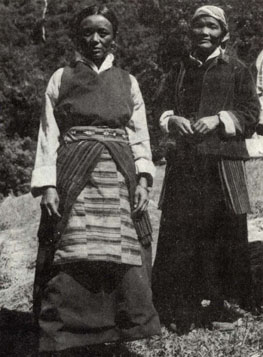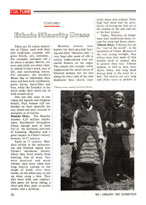There are 56 ethnic minorities in China, each with their own traditions, customs, religious beliefs, arts, costumes... For example, costumes tell a lot about a people. Motifs, colours and styles are often closely related to one’s work, way of life, and surrounding nature. For instance, the southern Miaos like to embroider their dress and hats with red flowers, green leaves, butterflies and bees, while the Ewenkis in the north make their dress out of wild animal skins.
One can also trace in costumes old legends and religious beliefs. Naxi women still embroider on their mantilla the sun, moon and stars revered in antiquity as divinities.
Manchu Dress. The Manchu number 4,29 million inhabitants, distributed throughout China, though most of them live in the northeast province of Liaoning. Manchus had a great impact in China’s history between 16-17 century.
Early in 17 century, Manchus settled in the mountainous and forested region near China’s northeast border, where they lived mostly from hunting. Out of need, they wore practical and warm clothes; men wore robes with long sleeves ending in the shape of hoofs over their hands, all the while easy to rollup when using a bow. They also wore wide and comfortable pants for horse riding, a short pale blue, pink, or scarlet jacket, and a skullcap.
Manchu women were known for their graceful bearing and their “Manchu robe”, a very long robe made of silk or cotton, embroidered with colourful flowers on the edges. The closed and straight collar emphasized the timid nature of Oriental women, but the slits along the lower side of the robe displayed their charm, especially when they walked. Their high heel shoes had the peculiarity of having the heel set in the middle of the sole and not at the heel proper.
Today, Manchus no longer wear their traditional dress, except for song and dance shows. Tibetan Dress. Tibetans live on the “roof of the world”, in the southwest of China. Because of the ever strong sunlight, they always wear hats made of thin woolen cloth or animal skin to protect their face. Tibetan women, as well as men, wear shirts, boots, and long thick dresses held at the waist by a belt. The sleeves are very long and often serve as pillows at night. Dresses are made of wool or silk, while lambskin is used for the lining, as well as the border of the sleeves and of the collar. Women also wear colourful embroidered aprons and they have a liking for necklaces, bracelets and earrings of gold, silver, jade, and coral.
Li Dress. The Lis live on Hainan Island, south of the Chinese mainland. Their costumes are still to this day handmade of thick cloth. The jacket is shaped like a sack, with no sleeves or opening, except for passing one’s head, and is tightened at the waist by a plain string. Women wear skirts shaped like an upside down bucket. Cotton cloth is often used, especially when it is very warm. The borders of the clothes are decorated with red, pink, or white cotton strips. The Li women are very creative and embroider their skirts with stylized designs of animals, plants, figures, water. They favour reds, blues, greens, yellows and whites, and blend these colours with various ornaments such as feathers, shells, pearls and bronze bells. During special holidays, the Li women adorn themselves with silver jewels that sing under the sea breeze.

Tibetan women wearing traditional dresses.


 Copy Reference
Copy Reference 